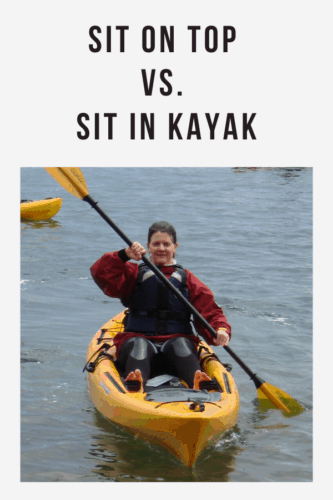To someone first entering the sport of kayaking, choosing a kayak from among the many different brands, types, purposes and, constructions can be a bit overwhelming!
So, how does a new paddler determine which kayak best suites their individual needs and intended purpose?
Well, the first step is to be aware that kayaks are divided into two different types consisting of sit-on-top and sit-inside designs because each design drastically differs from the other and each has its advantages and disadvantages over the other.
Therefore, the first step in choosing the best kayak for you is to first determine how you plan to use the kayak and then choose either a sit-on-top or a sit-inside design.
Table Of ContentsSit-On-Top KayaksAdvantages of a sit-on-top kayakDisadvantages of a sit-on-top kayakSit-Inside KayaksAdvantages of a sit-inside kayakDisadvantages of a sit-inside kayakFinal Thoughts
Sit-On-Top Kayaks
So, what defines a sit-on-top kayak and how does a person recognize one when they see it?
Well, as the name implies, sit-on-top kayaks lack an enclosed cockpit and thus, rather than the paddler being positioned inside of the kayak at or below the water level, they are instead positioned on top of the kayak above the water’s surface and, a prime example of this type of kayak is the Wilderness Systems Tarpon 120.
Therefore, this type of kayak is by far the most popular design among beginning paddlers and kayak fishermen because the sit-on-top design does not make a paddler feel like they are trapped inside of the kayak in the event of a capsize and, they are far easier to reenter if a paddler does accidentally capsize. So, what are the advantages and disadvantages of this type of kayak design?
Advantages of a sit-on-top kayak
- As mentioned above, the single greatest advantage of a sit-on-top kayak is that it has an open cockpit and thus, the paddler does not feel like they are confined within the kayak in the event of a capsize. Also, they are far easier to reenter in the event that a paddler does capsize.
- Because sit-on-top kayaks have a significantly higher center of gravity, they are also generally much wider than most sit-inside designs and thus, they generally have a much higher degree of initial stability (the tendency for the kayak to remain upright when the paddler is sitting in the kayak with the keel directly underneath them).
- Sit-on-top kayaks are literally unsinkable due to the completely enclosed design of their hulls.
- In the event of an accidental capsize, sit-on-top kayaks have self-bailing scupper holes to let the water drain out of the cockpit and thus they are an excellent choice for playing in the surf zone because paddlers do not have to carry a bilge pump with them.
- The open “tank well” in the stern provides plenty of room for carrying bulky items such as a cooler to keep things cold.
Disadvantages of a sit-on-top kayak
- Due to their relatively wide beam, sit-on-top kayaks are generally far slower than a sit-inside kayak of lesser width. Therefore, they require more effort from the paddler to propel them forward and thus, they are best suited for short range excursions and for kayak fishing.
- The wider beam width combined with the significantly higher center of gravity causes sit-on-top kayaks to have a much lower degree of secondary stability (the kayak’s tendency to stay upright when the kayak is leaned on its edge for turning and when paddling in rough seas).
- The open cockpit denies the paddler the ability to place their knees against the underside of the deck which limits the paddler’s control of the kayak as well as its maneuverability.
- The wide beam forces the paddler to use a longer paddle than they would with a more narrow sit-inside design and, the longer a kayak paddle is, the longer its Moment Arm is and thus, the more effort it requires to use it to propel the kayak forward.
- The open cockpit exposes the paddler to the elements and thus offers no protection from the Sun or from waves breaking over the bow or the gunwale.
- The significantly higher profile causes a sit-on-top kayak to be far more adversely affected by wind than a sit-inside kayak design.
- The self-draining scupper holes in the bottom of the kayak’s cockpit cause it to always have a small amount of water in the bilge.
Sit-Inside Kayaks
So, now that you know what a sit-on-top kayak looks like as well as their advantages and disadvantages, what defines a sit-inside kayak and how does a person recognize one when they see it?
There again, as the name implies, a sit-inside kayak has an enclosed cockpit and thus, rather than the paddler being positioned on top of the kayak, above the water level, the paddler is instead positioned below the water’s surface and, a prime example of this type of kayak is the Wilderness Systems Tempest.
Therefore, this type of kayak is by far the most popular design among intermediate and advanced paddlers because the sit-inside design provides a significantly lower center of gravity and thus, a much higher degree of secondary stability (the kayak’s tendency to stay upright when the kayak is leaned on its edge for turning and when paddling in rough seas).
So, what are the advantages and disadvantages of this type of kayak design?
Advantages of a sit-inside kayak
- The greatest advantage of a sit-inside kayak is that they have a much lower center of gravity than a sit-on-top design and thus, they have a much higher degree of secondary stability which enables the paddler to lean the kayak on its side for more efficient turning and to remain upright when paddling in rough seas.
- Due to their significantly lower center of gravity, a sit-inside kayak can also be made much more narrow than a sit-inside design and thus, they are generally much faster than a wide, sit-on-top, kayak design. Therefore, sit-inside kayaks require less effort from the paddler to propel them forward and thus, they are best suited for long range day paddling and expedition paddling.
- The enclosed cockpit of a sit-inside kayak provides the paddler with the ability to place their knees against the underside of the deck which greatly increases the paddler’s control of the kayak as well as its maneuverability.
- The enclosed cockpit also provides the paddler with some protection from the Sun and from waves breaking over the bow or the gunwale. Also, due to their integral cockpit coaming, a spray skirt can easily be attached to completely protect the paddler from the elements.
- The narrow beam enables a paddler to use a shorter paddle than they would with a wider sit-on-top design and, the shorter a kayak paddle is, the shorter its Moment Arm is and thus, the less effort it requires to use it to propel the kayak forward.
- The significantly lower profile causes a sit-inside kayak to be far less adversely affected by wind than a sit-on-top kayak design.
- The lack of self-draining scupper holes in the bottom of the kayak’s cockpit allows the cockpit to remain dry unless water is splashed into the cockpit by waves breaking over the bow
Disadvantages of a sit-inside kayak
- The single greatest disadvantage of a sit-inside kayak is that it has an open cockpit and thus, many paddlers feel like they are confined within the kayak in the event of a capsize. Also, they are far more difficult to reenter in the event that a paddler does capsize.
- Sit-inside kayaks can be sunk if both of their hatch covers come off in heavy seas and allows both the bow and stern holds to become filled with water.
- Because sit-inside kayaks have a significantly lower center of gravity, they are also generally much more narrow than most sit-on-top kayak designs and thus, they generally have a much lower degree of initial stability (the tendency for the kayak to remain upright when the paddler is sitting in the kayak with the keel directly underneath them).
- In the event of an accidental capsize, a sit-inside kayak is much more difficult to reenter than a sit-on-top kayak design. Also, paddlers have to use either a hand operated, foot operated or, battery operated bilge pump to remove the water from the cockpit.
- Due to the much smaller hatch covers and the lack of an open tank well in the stern, sit-inside kayaks are limited to only carrying items that are small enough to fit through the hatches.
Final Thoughts
So, as you can see, both sit-on-top and sit-inside kayak designs have both advantages and disadvantages over the other.
Consequently, sit-on-top kayaks are generally favored by both beginning paddlers and kayak fishermen who are looking for a kayak with a high degree of initial stability for short range excursions whereas, sit-inside kayak designs are generally favored by both intermediate and advanced paddlers who are looking for a fast kayak for long rage day paddling, extended camping trips, and expedition paddling.
Therefore, when choosing a kayak, it is very important that you first identify your intended purpose for the kayak and then purchase either a sit-on-top or a sit-inside design according to the purpose for which you intend to use the kayak most often.
More From KayakHelp:
- Sit On Top Kayak Reviews & Buying Guide
- Best Sit On Top Kayaks For Dogs
- Best Sit On Top Kayaks Under 300
- Best Sit On Top Kayak Locks
- Types Of Kayaks – What’s The Difference
- Best Kayak Bilge Pumps




